You’re about to discover how these 15 remarkable aroid plants can transform your indoor space with minimal effort. From the heart-shaped leaves of Philodendron Brasil to the dramatic splits of Monstera deliciosa, each variety brings its unique charm while sharing similar care requirements. Whether you’re a seasoned plant parent or just starting out, these adaptable beauties will thrive in your home’s conditions, especially if you can provide bright, indirect light and moderate humidity.
Contents
- 1 1. Philodendron Brasil’s Heart-Shaped Leaves
- 2 2. Monstera’s Split Leaf Pattern
- 3 3. Dieffenbachia’s Creamy White Spots
- 4 4. Chinese Evergreen’s Red Stems
- 5 5. Pothos’ Marbled Golden Variegation
- 6 6. Anthurium Crystallinum’s Velvety Foliage
- 7 7. ZZ Plant’s Waxy Stems
- 8 8. Peace Lily’s White Flowers
- 9 9. Colocasia’s Giant Leaves
- 10 10. Caladium’s Pink Speckled Foliage
- 11 11. Alocasia’s Dark Purple Underside
- 12 12. Scindapsus’ Shimmering Foliage
- 13 13. Syngonium’s Arrow-Shaped Leaves
- 14 14. Xanthosoma’s Bold Tropical Foliage
- 15 15. Rhaphidophora’s Intricate Fenestrations
1. Philodendron Brasil’s Heart-Shaped Leaves

Philodendron Brasil’s heart-shaped leaves are a defining characteristic of this popular trailing houseplant, featuring vibrant variegation patterns of lime green and cream striping against dark green foliage. Each leaf exhibits unique markings, with some leaves displaying more prominent striping than others, creating an eye-catching display. The leaves emerge tightly furled before unfurling to reveal their distinctive heart shape, growing to approximately 4-5 inches in length when mature.
- Light: Bright to moderate indirect light; avoid direct sunlight which can burn leaves
- Water: Allow top 1-2 inches of soil to dry between waterings; reduce watering in winter
- Soil: Well-draining, loose potting mix rich in organic matter
- Humidity: Prefers 60% or higher; benefits from regular misting
- Temperature: 65-80°F (18-27°C)
- Fertilizer: Monthly feeding during growing season with balanced houseplant fertilizer
- Potting: Use containers with drainage holes; repot every 2-3 years
- Support: Provide moss pole or trellis for climbing growth habit
2. Monstera’s Split Leaf Pattern
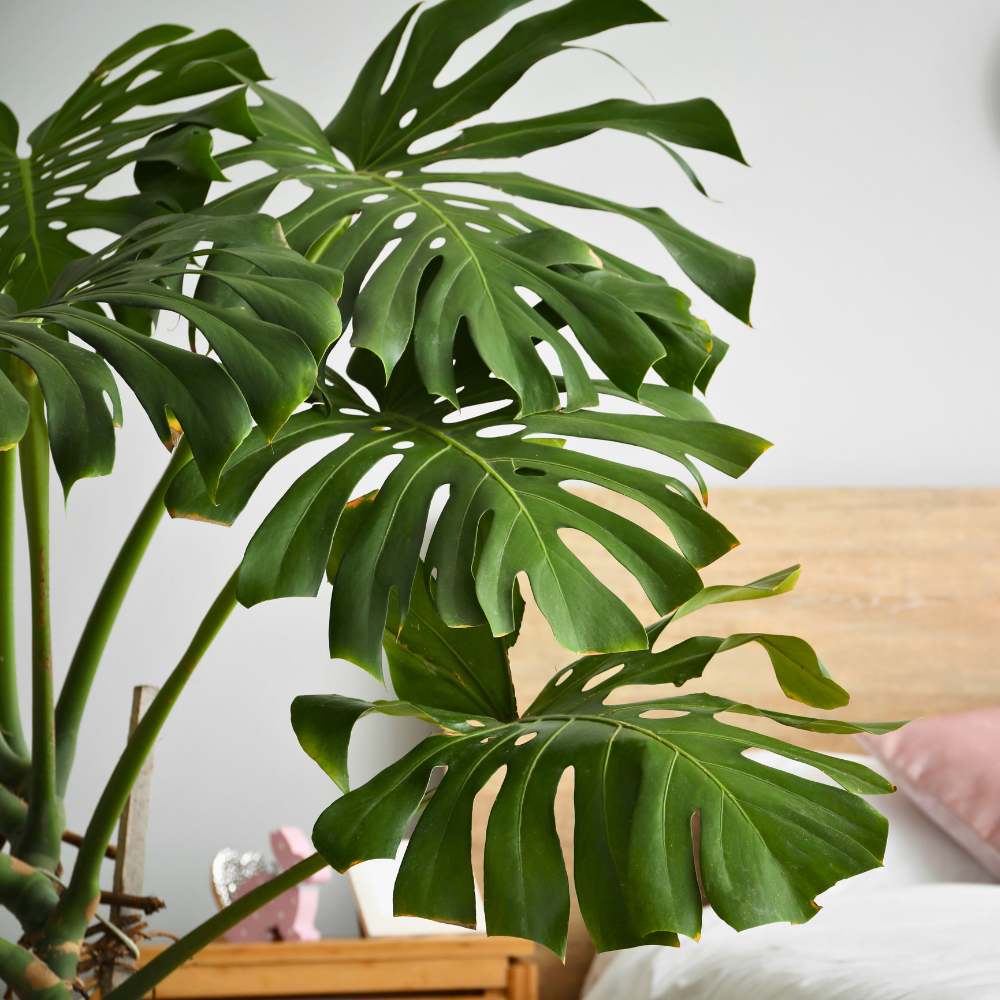
The iconic split leaves of Monstera deliciosa develop as the plant matures, with young leaves starting out whole and gradually developing their characteristic fenestrations (holes) and deep splits. This pattern, known as leaf fenestration, serves multiple purposes in the plant’s natural habitat, including allowing light to reach lower leaves, reducing wind resistance, and channeling water to the plant’s root system. The splits begin forming from the leaf’s edge and progress inward, while holes develop within the leaf surface, creating the distinctive Swiss cheese appearance that makes these plants so popular in interior design.
- Light: Bright, indirect light; can tolerate some direct morning sun but avoid harsh afternoon rays
- Water: Allow top 2-3 inches of soil to dry between waterings; reduce watering in winter
- Soil: Well-draining, rich potting mix with added perlite and orchid bark
- Humidity: Prefers 60-80% humidity; tolerates average household levels
- Temperature: 65-85°F (18-29°C)
- Fertilizer: Monthly feeding during growing season with balanced liquid fertilizer
- Support: Climbing pole or trellis to encourage larger leaves and more splitting
3. Dieffenbachia’s Creamy White Spots

Dieffenbachia’s distinctive creamy white spots are a defining characteristic of this popular indoor aroid. These spots and patches appear randomly across the large, oval leaves, creating a striking variegated pattern against the dark green background. The spots can vary in size and distribution, with some varieties displaying more prominent variegation than others. This natural pattern is caused by a genetic variation that affects chlorophyll production in certain leaf areas, resulting in the characteristic white or cream-colored markings.
- Light: Bright, indirect light; avoid direct sunlight which can burn leaves; tolerates moderate shade
- Water: Keep soil consistently moist but not waterlogged; water when top 1-2 inches of soil feels dry
- Soil: Well-draining, rich potting mix with organic matter
- Humidity: Prefers high humidity (60-70%); mist regularly or use a humidity tray
- Temperature: 65-75°F (18-24°C); protect from cold drafts
- Fertilizer: Feed monthly during growing season with balanced houseplant fertilizer
- Potting: Use containers with drainage holes; repot every 2-3 years as needed
4. Chinese Evergreen’s Red Stems
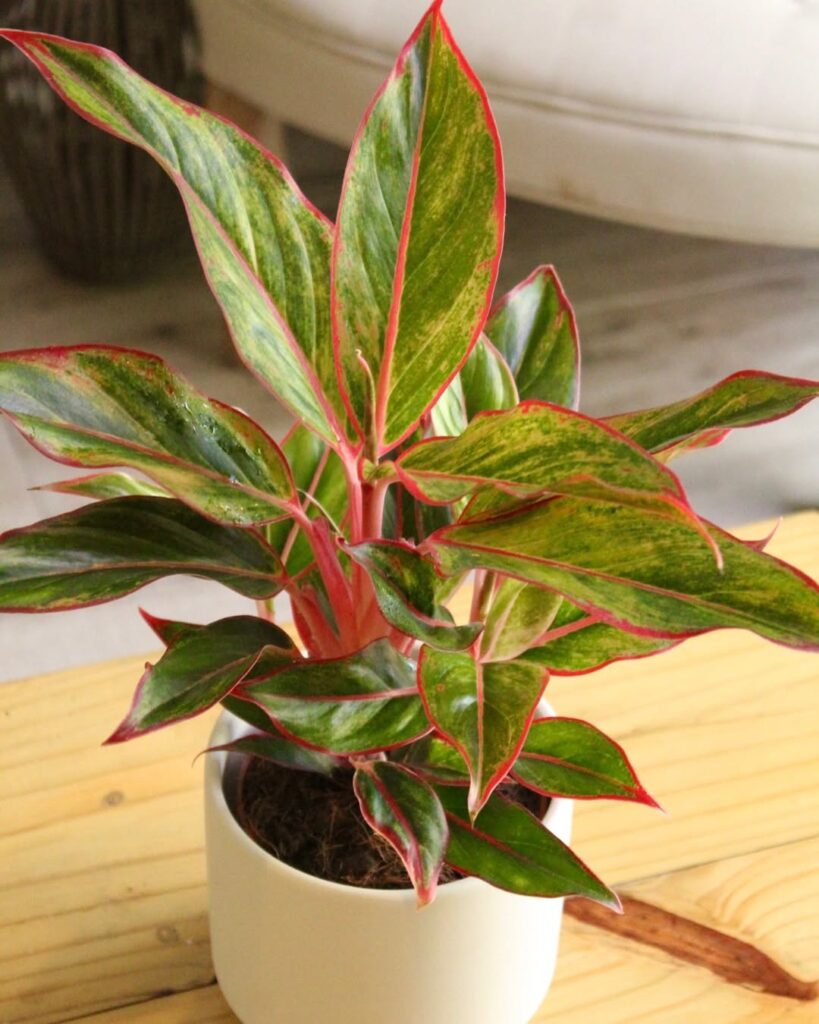
Chinese Evergreen plants with red stems are striking cultivars of Aglaonema that feature vibrant reddish-pink to deep crimson petioles contrasting beautifully with their variegated foliage. The red stems add an extra dimension of visual interest to these already attractive houseplants, making them popular choices for indoor decoration. These colorful varieties were developed through selective breeding of traditional green Aglaonemas, resulting in stunning specimens that maintain the same hardy nature as their original counterparts.
- Light: Moderate to low indirect light; avoid direct sunlight which can fade the stem coloration
- Water: Keep soil consistently moist but not waterlogged; water when top 1-2 inches of soil feels dry
- Soil: Well-draining potting mix rich in organic matter
- Humidity: Prefers 50% or higher humidity levels
- Temperature: 65-80°F (18-27°C)
- Fertilizer: Feed monthly with balanced liquid fertilizer during growing season
- Potting: Use containers with drainage holes
- Soil pH: 5.6-6.5
5. Pothos’ Marbled Golden Variegation
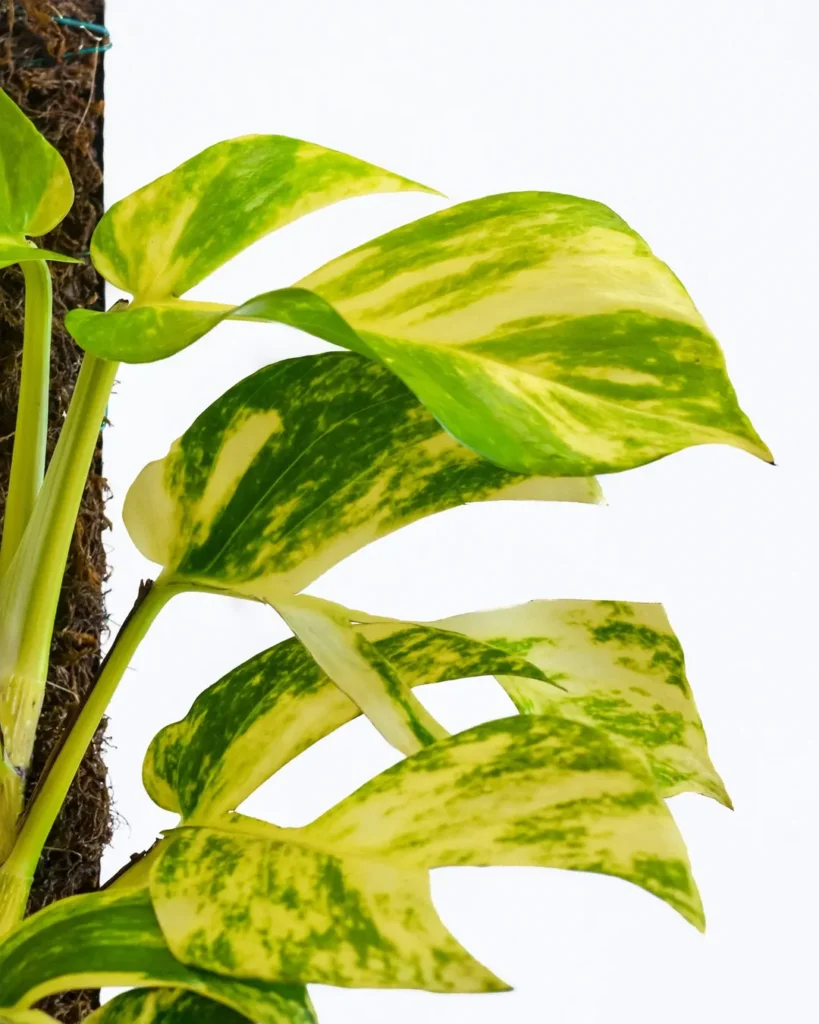
Pothos’ marbled golden variegation is a striking pattern found on the leaves of Epipremnum aureum, featuring irregular splashes and streaks of yellow-gold against green foliage. This variegation pattern creates a marble-like effect that makes each leaf unique, with some showing more prominent golden patches while others display subtle streaking. The intensity and amount of variegation can vary depending on lighting conditions, with brighter light typically promoting more pronounced golden patterns.
- Light: Bright, indirect light; can tolerate medium light but variegation may fade; avoid direct sunlight
- Water: Allow top 1-2 inches of soil to dry between waterings; reduce frequency in winter
- Soil: Well-draining potting mix rich in organic matter
- Humidity: Tolerates average indoor humidity levels (40-60%)
- Temperature: 60-80°F (15-27°C)
- Fertilizer: Balanced liquid fertilizer every 4-6 weeks during growing season
- Soil pH: 6.1-6.5
6. Anthurium Crystallinum’s Velvety Foliage
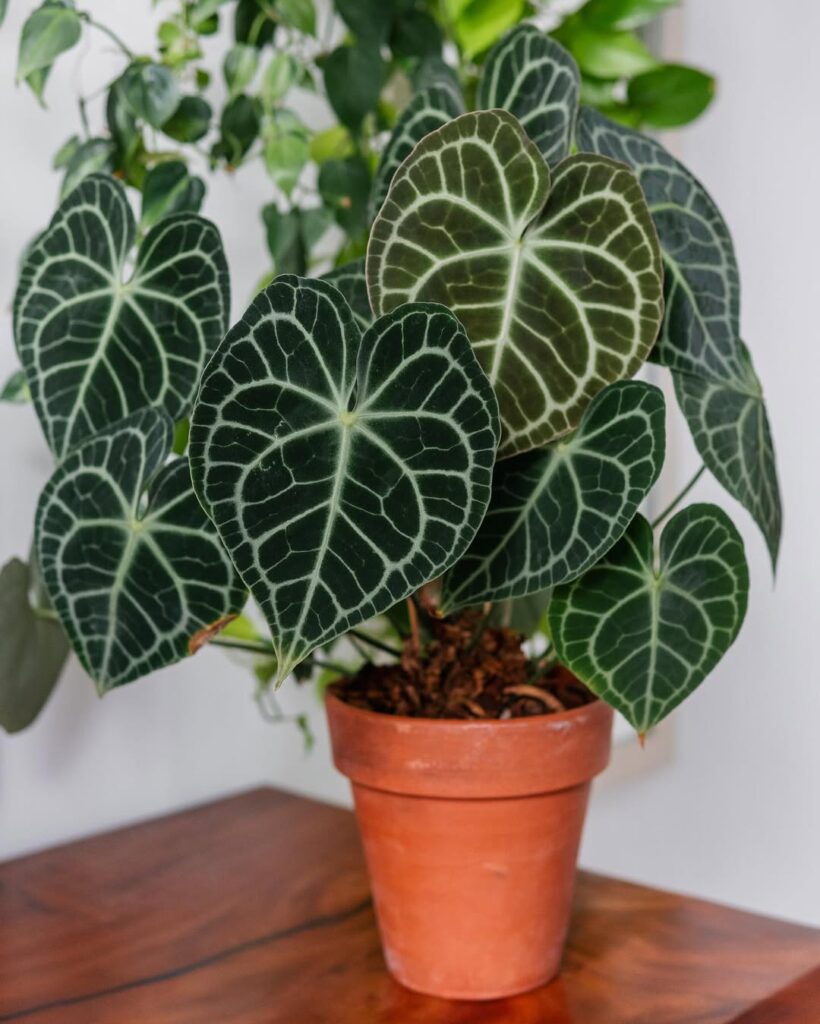
Anthurium crystallinum is a foliage-focused Anthurium known for its heart-shaped, deep green leaves adorned with silvery-white veins. Unlike its blooming relatives, this species captivates with its lush, velvety texture rather than colorful spathes. Its ornamental appeal makes it a favorite among indoor plant enthusiasts, thriving in high humidity and bright, indirect light.
- Light: Bright, indirect light; avoid direct sun to prevent leaf scorch
- Water: Keep soil evenly moist but allow the top inch to dry between waterings
- Soil: Well-draining mix with orchid bark, perlite, and peat moss
- Humidity: High humidity (60-80%); use a humidifier or pebble tray
- Temperature: 65-80°F (18-27°C); avoid cold drafts
- Fertilizer: Feed monthly with a balanced, diluted fertilizer during the growing season
- Repotting: Every 2-3 years or when roots outgrow the pot
7. ZZ Plant’s Waxy Stems
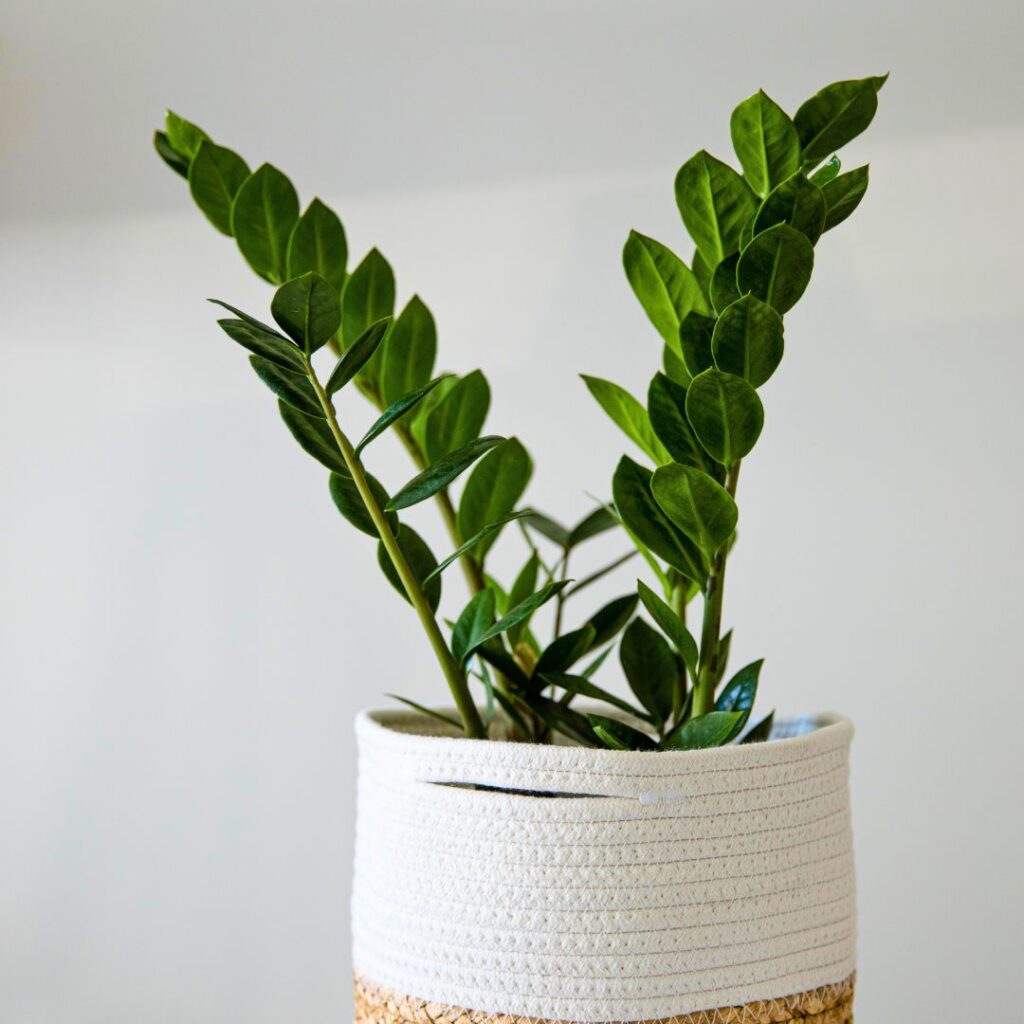
ZZ plants (Zamioculcas zamiifolia) feature distinctive waxy stems that grow upright from underground rhizomes, giving the plant its characteristic appearance. These thick, fleshy stems are naturally glossy and smooth, serving as water storage organs that help the plant survive drought conditions. The stems branch out to support compound leaves with oval-shaped leaflets, which share the same waxy coating, making the entire plant appear artificial or plastic-like.
- Light: Tolerates low to bright indirect light; avoid direct sunlight
- Water: Allow soil to dry between waterings; water sparingly every 2-3 weeks
- Soil: Well-draining potting mix with perlite or sand
- Humidity: Adaptable to average indoor humidity levels
- Temperature: 65-75°F (18-24°C)
- Fertilizer: Light feeding every 3-4 months during growing season
- Pot: Container with drainage holes to prevent root rot
- Growing Medium pH: 6.0-7.0
8. Peace Lily’s White Flowers
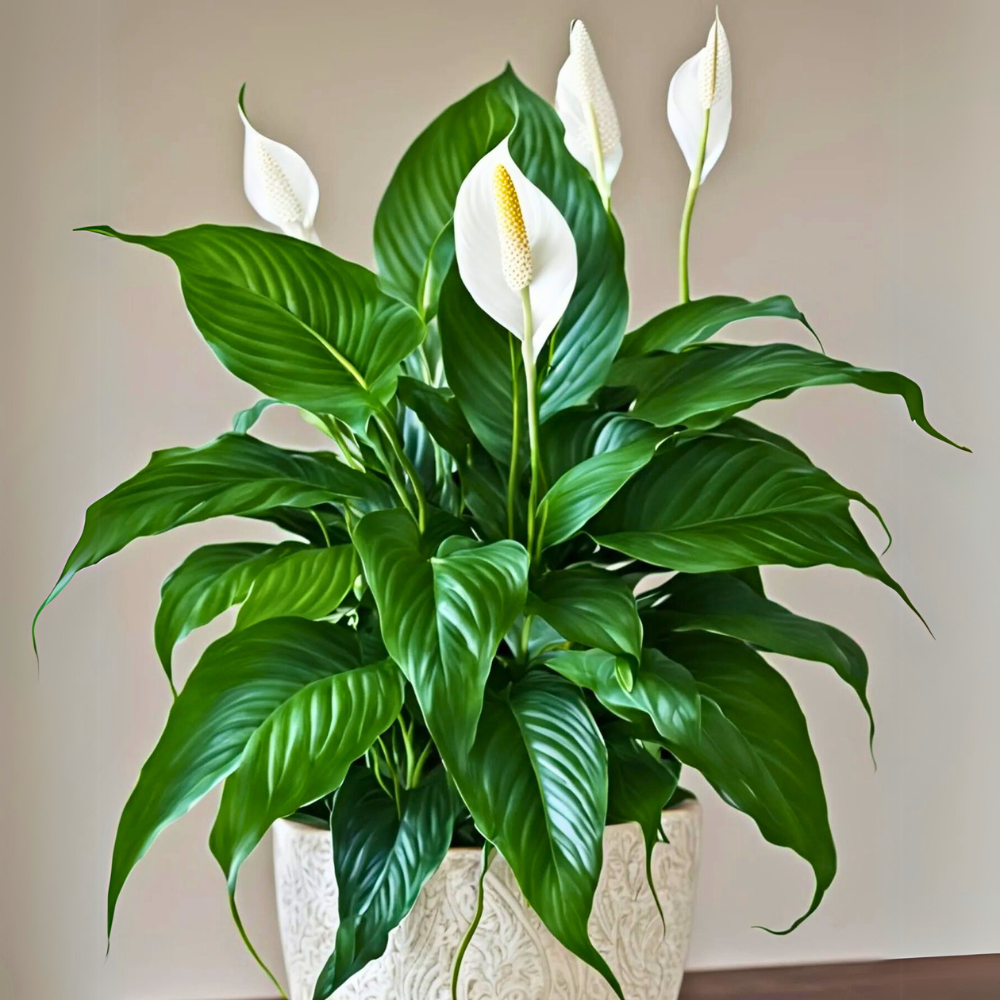
Peace Lily’s white flowers are one of the most distinctive features of this popular houseplant. The elegant blooms consist of a white, hood-like spathe surrounding a protruding spadix, creating a striking contrast against the plant’s dark green foliage. These flowers typically appear throughout the year but bloom most prolifically in spring and early summer. While often referred to as flowers, the white spathe is actually a modified leaf that cradles the true tiny flowers found on the spadix.
- Light: Bright indirect light to partial shade; avoid direct sunlight
- Water: Keep soil consistently moist but not waterlogged; water when top inch of soil feels dry
- Soil: Well-draining potting mix rich in organic matter
- Humidity: Prefers high humidity levels (50% or higher)
- Temperature: 65-80°F (18-27°C)
- Fertilizer: Light feeding with balanced fertilizer every 6-8 weeks during growing season
- Flowering Trigger: Mature plants flower best when slightly pot-bound
9. Colocasia’s Giant Leaves
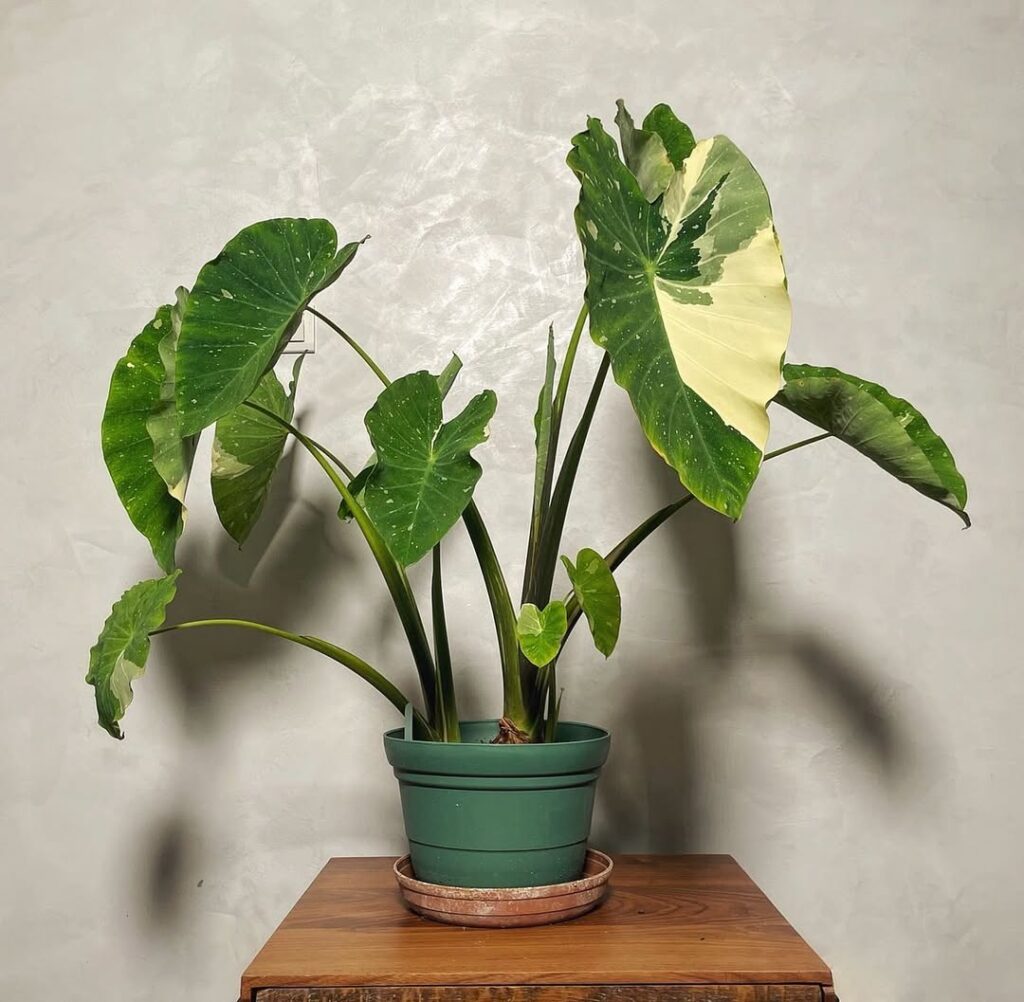
Elephant ear plants are known for their impressively large, heart-shaped or arrow-shaped leaves that can grow several feet in length and width. These dramatic foliage plants, belonging to the genera Colocasia and Alocasia, create an instant tropical feel indoors with their commanding presence. The leaves often display striking variations in color, from deep green to near-black, and some varieties feature prominent veining or variegated patterns that add to their visual appeal.
- Light: Bright, indirect light; can tolerate some direct morning sun but protect from harsh afternoon rays
- Water: Keep soil consistently moist but not waterlogged; water when top inch of soil feels dry
- Soil: Rich, well-draining potting mix with high organic matter content
- Humidity: High humidity levels (60% or higher); regular misting or use of humidity tray recommended
- Temperature: Warm conditions between 65-85°F (18-29°C)
- Fertilizer: Monthly feeding during growing season with balanced liquid fertilizer
- Container: Large pot with adequate drainage holes to accommodate extensive root system
- Maintenance: Remove yellowing leaves promptly; dust large leaves regularly to maintain photosynthesis
10. Caladium’s Pink Speckled Foliage
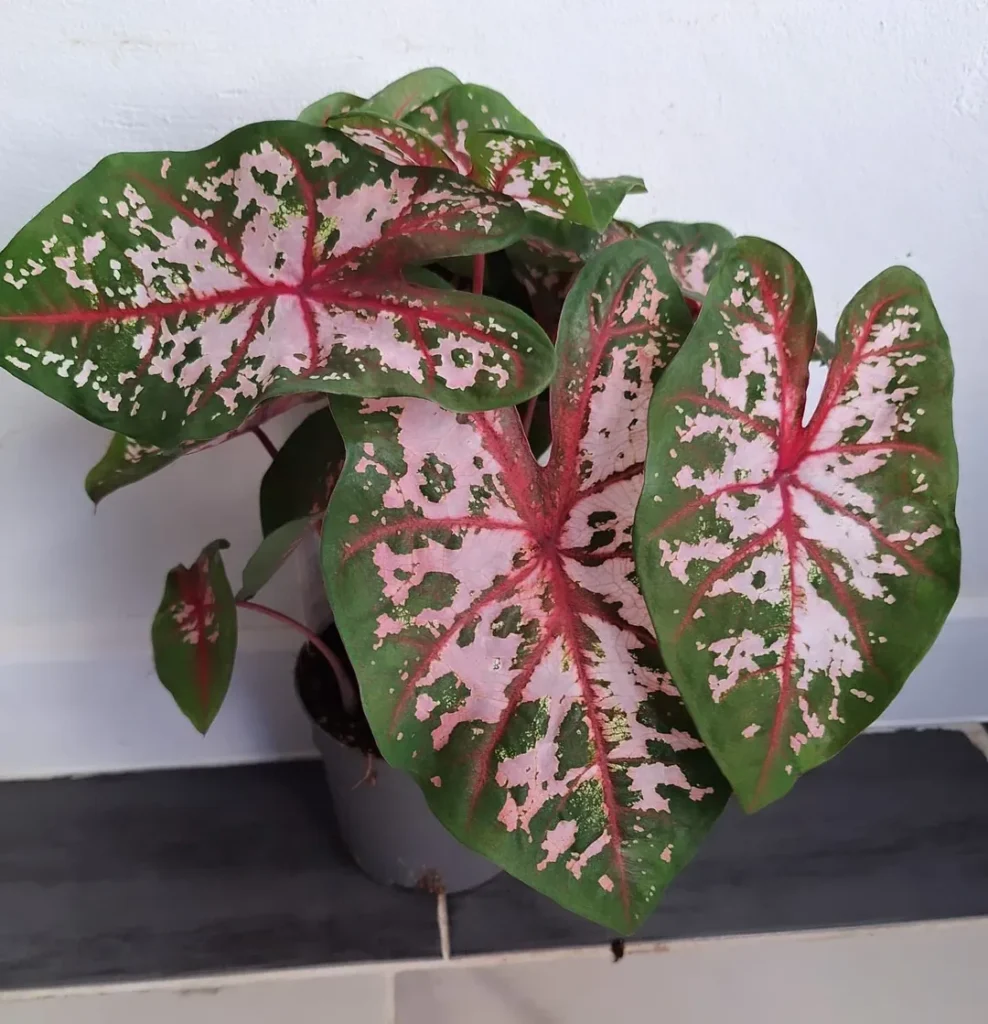
Caladium’s pink speckled foliage features heart-shaped leaves adorned with intricate patterns of pink, white, and green hues. These delicate, paper-thin leaves emerge from tubers and create a stunning tropical display with their speckled, mottled, or veined patterns. The pink variations can range from soft blush to vibrant rose, often contrasting beautifully with darker green edges or silvery undertones.
- Light: Bright, indirect light; avoid direct sunlight which can burn leaves
- Water: Keep soil consistently moist but not waterlogged; reduce watering in dormant period
- Soil: Well-draining, rich potting mix with high organic content
- Humidity: High humidity levels (60-70%)
- Temperature: Warm conditions between 65-85°F (18-29°C)
- Fertilizer: Monthly feeding during growing season with balanced liquid fertilizer
- Growth Period: Active growth in spring and summer; goes dormant in winter
- Space: Plant tubers 4-6 inches deep and 4-8 inches apart
11. Alocasia’s Dark Purple Underside
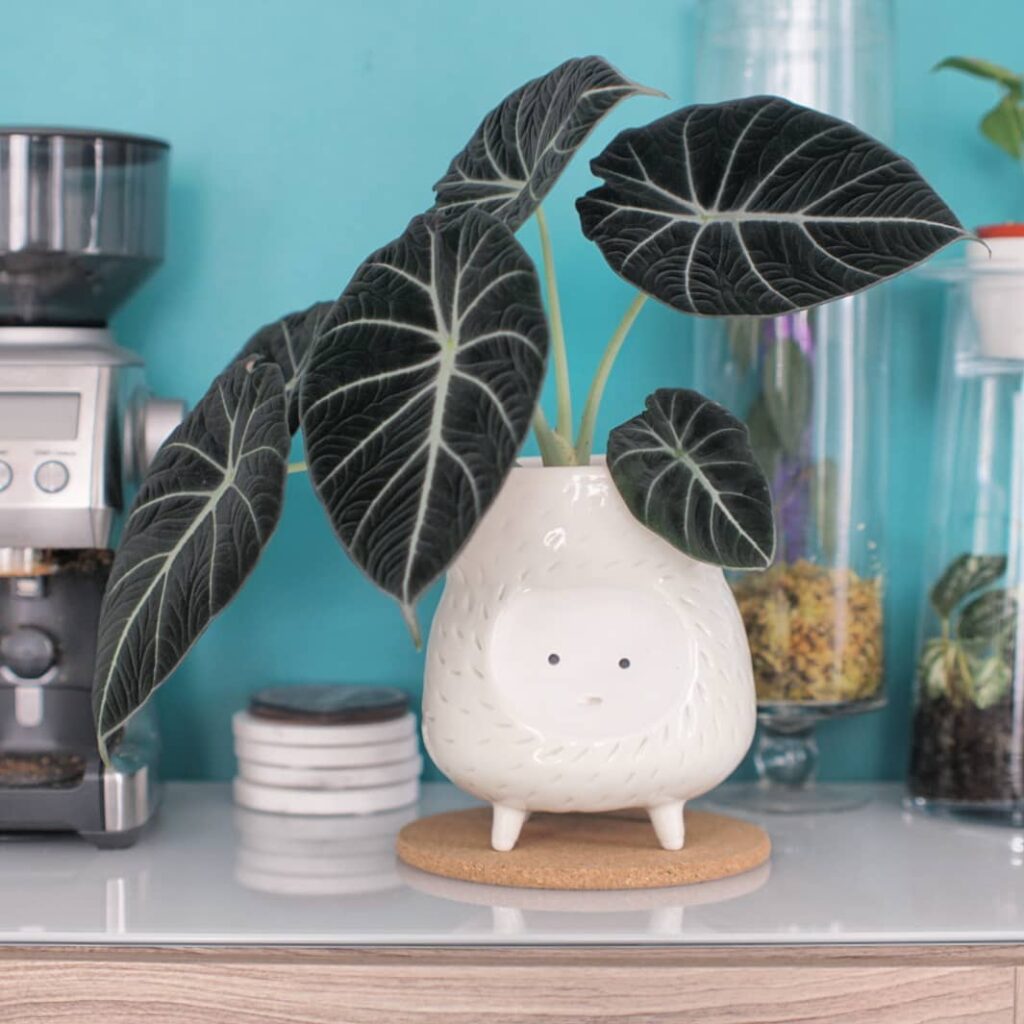
The dark purple underside of Alocasia leaves is a striking characteristic found in several species within the genus, most prominently in Alocasia reginula ‘Black Velvet’ and Alocasia baginda ‘Dragon Scale.’ This distinctive coloration serves as both an ornamental feature and a natural adaptation, where the purple pigmentation helps the plant absorb and utilize different light wavelengths. The contrast between the typically dark green or silvery top surface and the purple underside creates a dramatic visual effect, especially when the leaves move or catch the light at different angles.
- Light: Bright indirect light; avoid direct sunlight which can damage leaves
- Water: Keep soil consistently moist but not waterlogged; water when top inch of soil feels dry
- Soil: Well-draining, rich potting mix with added perlite and orchid bark
- Humidity: High humidity (60-80%); use humidifier or pebble tray
- Temperature: Warm environment between 65-85°F (18-29°C)
- Fertilizer: Monthly feeding during growing season with balanced fertilizer
- Soil pH: Slightly acidic to neutral (6.0-7.0)
12. Scindapsus’ Shimmering Foliage
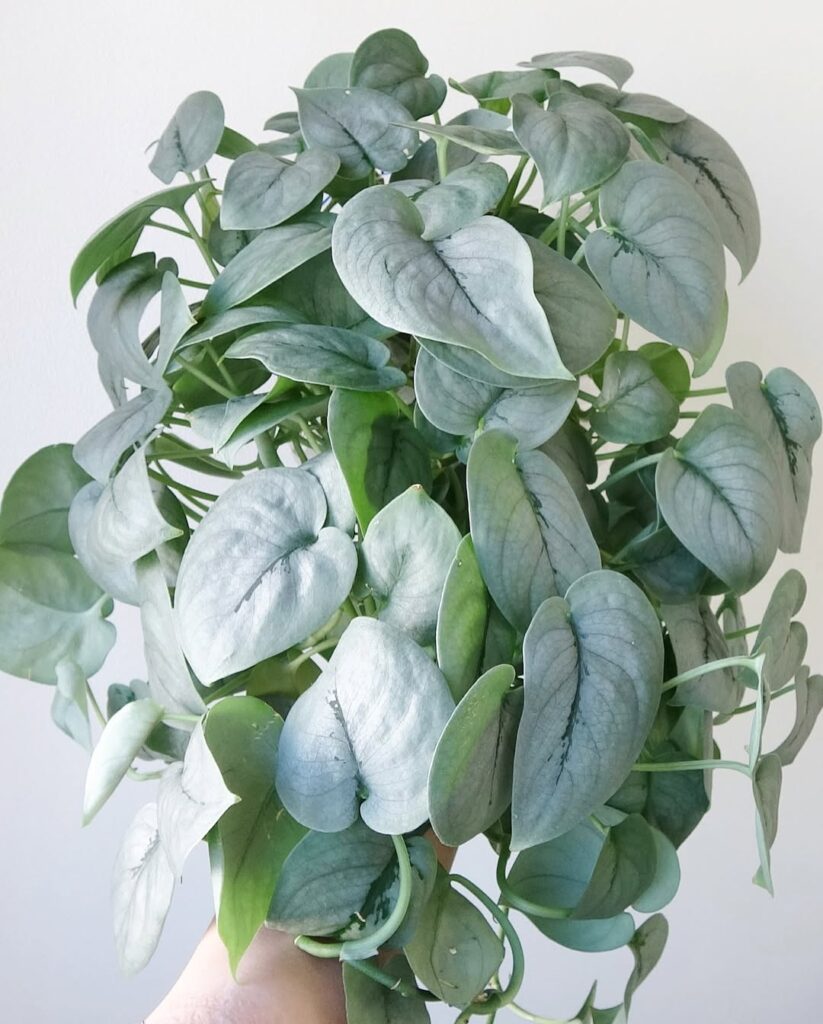
Scindapsus species, often mistaken for Pothos, boast thicker, more textured leaves with a metallic sheen. Varieties like Scindapsus pictus ‘Exotica’ feature silvery variegation, adding a luminous touch to indoor spaces. These trailing vines thrive in low to medium light, making them excellent choices for shaded corners.
- Repotting: Every 2-3 years when roots outgrow the pot
- Light: Medium to low indirect light; tolerates lower light than Pothos
- Water: Allow soil to dry slightly between waterings
- Soil: Well-draining mix with perlite and peat moss
- Humidity: Moderate; benefits from occasional misting
- Temperature: 65-80°F (18-27°C)
- Fertilizer: Feed monthly with a balanced liquid fertilizer
13. Syngonium’s Arrow-Shaped Leaves

Syngonium, commonly known as arrowhead plant, features distinctly arrow-shaped leaves that transform as the plant matures. Young leaves display the classic arrowhead form, while mature leaves can develop into compound shapes with multiple leaflets. The foliage comes in various colors and patterns, from solid green to variegated combinations of white, cream, and pink, making it an attractive indoor specimen.
- Light: Bright, indirect light; can tolerate medium light but may lose variegation in low light conditions
- Water: Keep soil consistently moist but not waterlogged; allow top inch of soil to dry between waterings
- Soil: Well-draining, fertile potting mix rich in organic matter
- Humidity: Prefers high humidity (50-60%); mist regularly or use a humidity tray
- Temperature: 60-80°F (15-27°C)
- Fertilizer: Feed monthly during growing season with balanced liquid fertilizer
- Container: Use pot with drainage holes to prevent root rot
14. Xanthosoma’s Bold Tropical Foliage
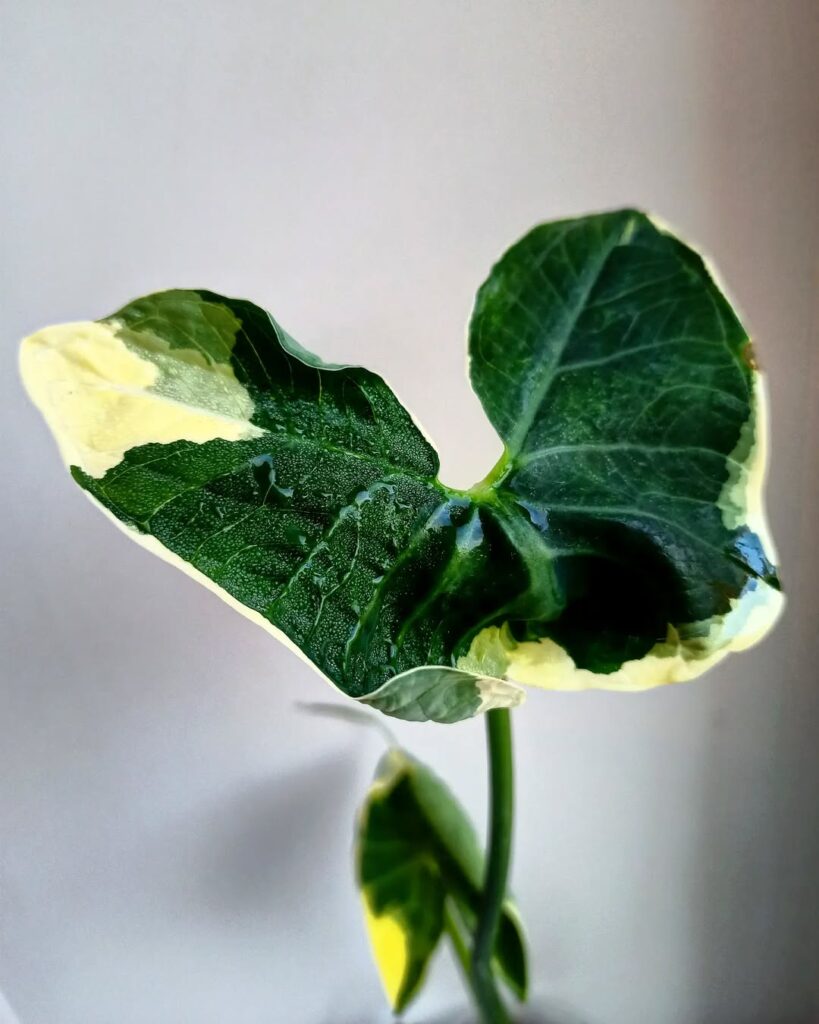
Xanthosoma species are known for their large, arrow-shaped leaves that bring a dramatic, tropical feel to indoor spaces. Xanthosoma sagittifolium, commonly called “Elephant Ear,” thrives in warm, humid environments and makes a stunning statement plant.
- Repotting: Every 2-3 years or when roots become crowded
- Light: Bright, indirect light; tolerates some shade
- Water: Keep soil consistently moist but avoid waterlogging
- Soil: Rich, well-draining mix with organic matter
- Humidity: High humidity (60-80%); misting helps maintain moisture
- Temperature: 70-85°F (21-29°C); protect from cold drafts
- Fertilizer: Feed every 4-6 weeks with a nitrogen-rich fertilizer
15. Rhaphidophora’s Intricate Fenestrations
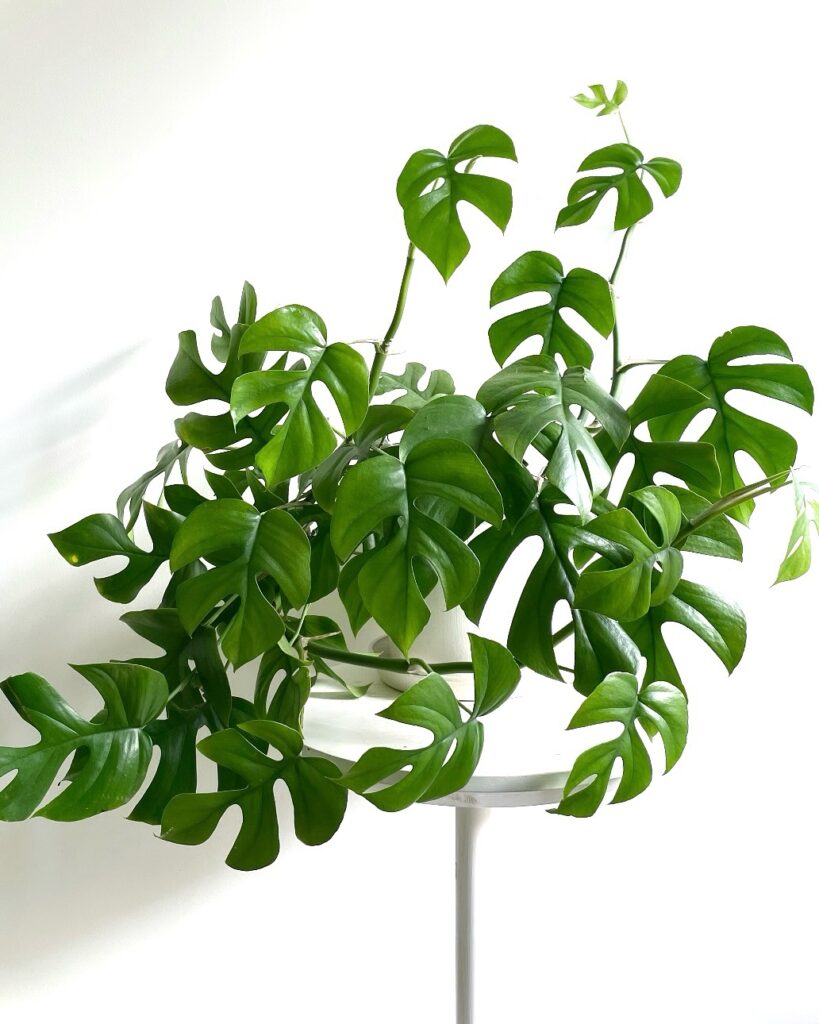
Rhaphidophora species, often mistaken for Monstera, feature deeply fenestrated leaves that develop striking perforations as they mature. Rhaphidophora tetrasperma, commonly called “Mini Monstera,” is a compact climber perfect for indoor spaces. These plants thrive in bright, indirect light and high humidity, making them excellent choices for tropical-themed interiors.
- Repotting: Every 2-3 years or when roots outgrow the pot
- Light: Bright, indirect light; tolerates medium light but grows slower
- Water: Keep soil evenly moist but allow the top inch to dry between waterings
- Soil: Well-draining mix with orchid bark, perlite, and peat moss
- Humidity: High humidity (60-80%); benefits from misting or a humidifier
- Temperature: 65-80°F (18-27°C); avoid cold drafts
- Fertilizer: Feed monthly with a balanced liquid fertilizer
